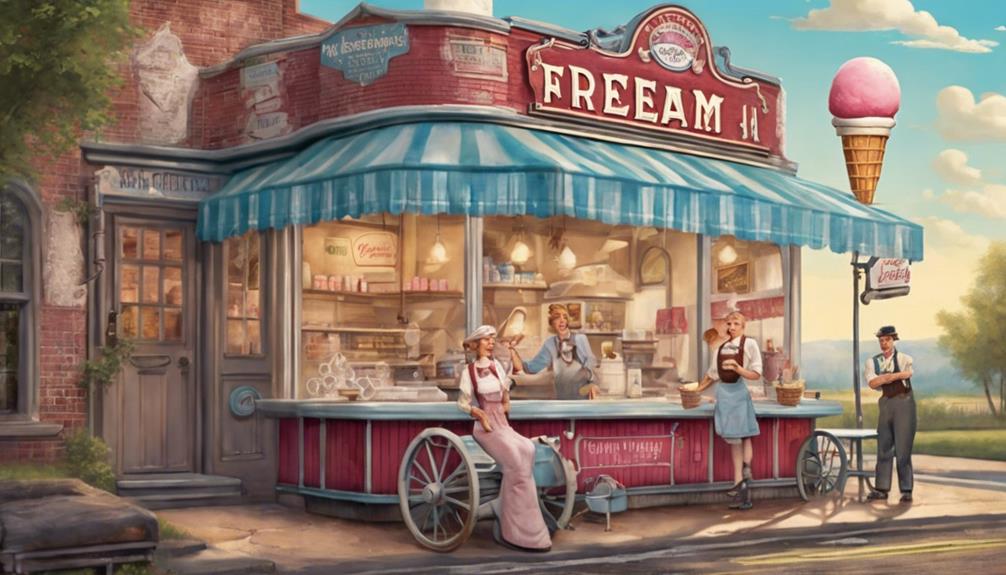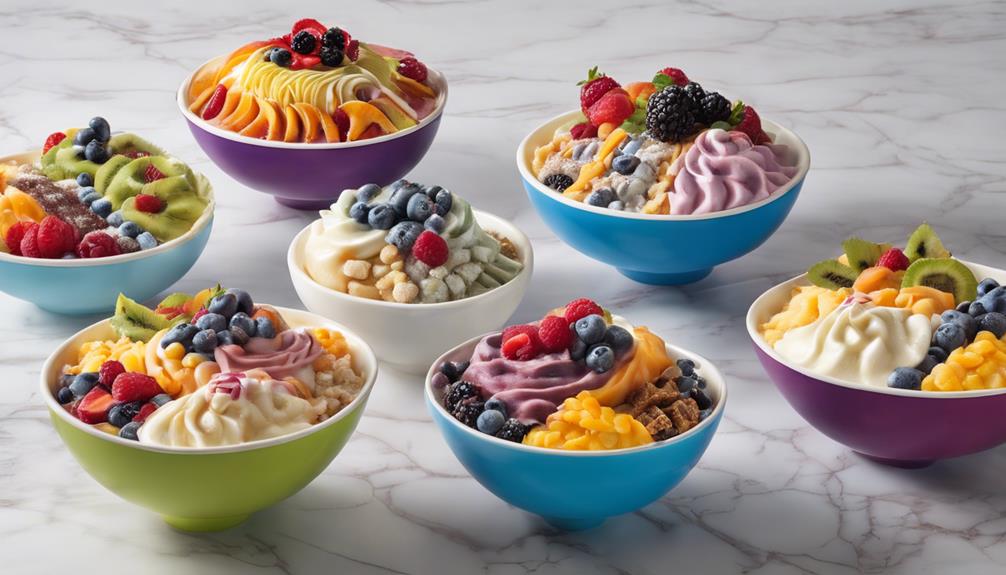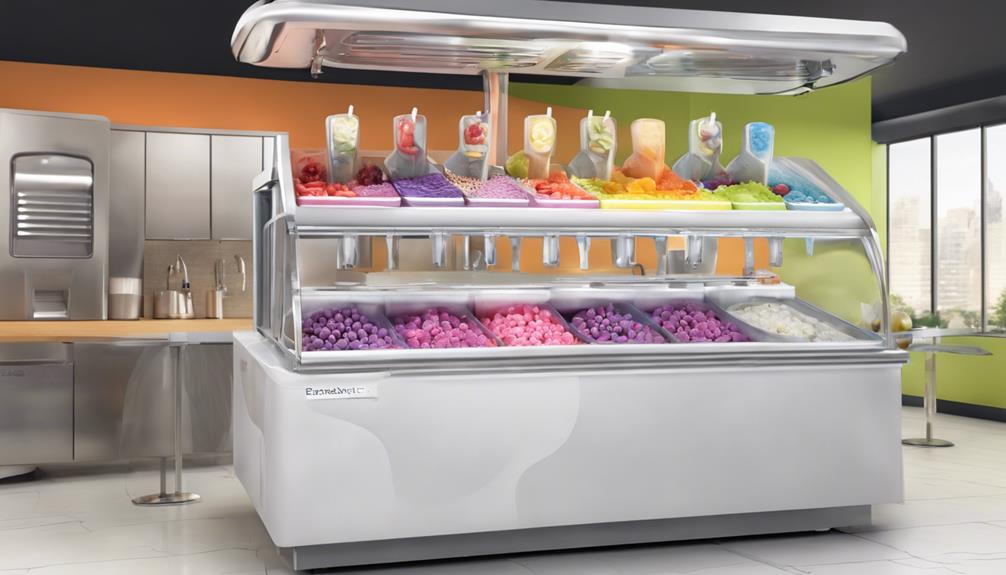When you think about the frozen yogurt industry, it's easy to overlook the trailblazers who laid its foundation. Imagine the 1970s, when H.P. Hood introduced the world to soft-serve frozen yogurt, setting a precedent for future innovations. You might be curious about how brands like TCBY and Pinkberry leveraged strategic branding to carve out their niche and influence market trends. These pioneers and innovators didn't just create a dessert; they ignited a revolution in flavor experimentation and health-conscious choices. So, what exactly did they bring to the table that changed everything?
Key Takeaways
- H.P. Hood introduced soft-serve frozen yogurt in the 1970s, pioneering the industry.
- TCBY, founded in 1981, revolutionized the market with strategic branding and franchising.
- Pinkberry, debuting in 2005, transformed the industry with customizable options.
- TCBY became the world's largest frozen yogurt chain by 2000.
- Pinkberry's innovations significantly contributed to the industry's growth to $2.1 billion by 2019.
The Pioneers

The pioneers of frozen yogurt, particularly H.P. Hood with his 1970s soft-serve dessert and TCBY's groundbreaking shop in 1981, laid the cornerstone for what would become a multimillion-dollar industry by the mid-1980s. H.P. Hood's introduction of frozen yogurt provided a healthier alternative to traditional ice cream, appealing to the growing health-conscious demographic of the 1970s. This innovation in the dessert landscape set the stage for the emergence of dedicated frozen yogurt chains.
TCBY, or "The Country's Best Yogurt," opened its first store in Little Rock, Arkansas, in 1981. This marked a pivotal moment in the commercial viability of frozen yogurt. TCBY's strategic approach to branding and franchising rapidly expanded its presence, effectively popularizing frozen yogurt as a mainstream dessert option. By 1986, TCBY's success had catapulted the industry to a remarkable $25 million in revenue, underscoring the significant consumer demand.
These early endeavors by H.P. Hood and TCBY not only established the initial framework for frozen yogurt chains but also demonstrated the commercial potential of this innovative dessert. Their pioneering efforts were instrumental in shaping an industry that would continue to evolve and grow in subsequent decades.
The Innovators
You'll find that the innovators in frozen yogurt history revolutionized both the product and the market. Pioneering brands like TCBY and Pinkberry not only introduced new flavors and textures but also created unique consumer experiences that reshaped the industry. These advancements, coupled with industry-changing inventions, propelled frozen yogurt into a multi-billion-dollar market.
Pioneering Frozen Yogurt Brands
Pioneering the frozen yogurt industry, H.P. Hood introduced the concept of soft-serve frozen yogurt in the 1970s, setting the stage for future innovators. This initial foray into frozen yogurt laid the groundwork for one of the most dynamic sectors within the frozen dessert market. H.P. Hood's innovation marked the beginning of a notable shift in consumer preferences towards healthier dessert options.
In 1981, TCBY (The Country's Best Yogurt) opened the first frozen yogurt shop, catalyzing industry growth. TCBY's introduction of self-serve frozen yogurt options allowed customers to enjoy a personalized dessert experience, which greatly boosted the brand's popularity and heralded a new era for frozen yogurt. During the 1990s, frozen yogurt captured approximately 10% of the frozen dessert market, underscoring its widespread acceptance and demand.
Pinkberry's debut in 2005 further revolutionized the industry by offering customizable frozen yogurt options, sparking a renaissance. Pinkberry's unique approach and high-quality ingredients set a new standard for frozen yogurt, inspiring numerous competitors and expanding consumer interest. The market's projected growth to $2.1 billion by 2019 highlights the enduring appeal and evolving nature of frozen yogurt, proving that these pioneering brands have left an indelible mark on the industry.
Industry-Changing Inventions
When examining the industry's evolution, you'll find that groundbreaking inventions like self-service machines and customizable toppings have played critical roles in transforming the frozen yogurt experience. These innovations have not only enhanced customer engagement but also streamlined operations in frozen yogurt shops. The first major shift occurred with the introduction of self-service machines, allowing customers to control portion sizes and mix flavors to their preference. This democratization of the serving process led to a more personalized experience.
The concept of customizable toppings further revolutionized the industry. By offering an array of choices—from fresh fruits to candy pieces—frozen yogurt shops could cater to a wide range of tastes and dietary preferences. This not only increased customer satisfaction but also encouraged repeat business.
- Self-service machines: Empowered customers to serve themselves, increasing engagement.
- Customizable toppings: Allowed for a personalized dessert experience, boosting customer satisfaction.
- Operational efficiency: Reduced labor costs and streamlined service.
- Customer retention: Enhanced experience led to greater loyalty and repeat visits.
- Market differentiation: Helped frozen yogurt shops stand out in a competitive market.
These innovations collectively contributed to the significant projected revenue growth of the frozen yogurt industry, which was expected to reach $2.1 billion by 2019.
Commercial Success

The commercial success of frozen yogurt can be traced back to the early 1980s, with the establishment of TCBY in 1981, which rapidly expanded to become the world's largest frozen yogurt chain. By 2000, TCBY boasted 3,000 locations across 70 countries, cementing its dominance in the burgeoning frozen dessert market. The brand's remarkable growth highlights a pivotal moment in the history of frozen yogurt, demonstrating its widespread appeal and robust commercial potential.
By 1986, the frozen yogurt market had already achieved $25 million in sales, and by the 1990s, it had captured a significant 10% of the overall frozen dessert market. This period marked a significant shift as consumers began to favor frozen yogurt for its perceived health benefits over traditional ice cream.
The 21st-century resurgence of frozen yogurt was sparked by Pinkberry's debut in 2005, which revitalized interest and innovation within the industry. This resurgence led to a projected market revenue of $2.1 billion by 2019. Other notable contributors to the commercial landscape include Freshëns, founded in 1985, which targeted non-traditional locations like college campuses and airports, and Menchie's Frozen Yogurt, established in 2007, known for its customizable frozen yogurt experiences.
Flavor Masters
As you delve into the world of Flavor Masters, you'll uncover their pivotal role in crafting unique taste profiles that balance sweet and tangy notes. These experts also keenly monitor and respond to seasonal flavor trends, ensuring offerings remain fresh and intriguing. Their contributions are fundamental to the sustained growth and competitive edge of frozen yogurt establishments.
Innovating Unique Taste Profiles
Flavor Masters, with their unparalleled expertise and innovative spirit, have revolutionized the frozen yogurt industry by crafting unique and enticing taste profiles that captivate and delight consumers. These flavor innovators are not merely content with traditional offerings; they consistently push the boundaries to create signature flavors that stand out in the competitive market. Their mastery in blending diverse ingredients and employing advanced techniques has made them pivotal in shaping the industry's landscape.
As a consumer, you've likely enjoyed the fruits of their labor through a variety of innovative flavors. These experts meticulously experiment with:
- Classic flavors such as vanilla and chocolate
- Seasonal offerings like pumpkin spice during autumn
- Exotic profiles including lychee and matcha
- Health-conscious blends featuring probiotics and low-sugar options
- Trend-driven choices influenced by popular culinary movements
These unique taste profiles are not just about mixing ingredients; they are the result of a deep understanding of consumer preferences and market trends. By continually exploring new flavor combinations and perfecting their craft, Flavor Masters make certain that frozen yogurt remains a dynamic and exciting treat for all. Their contributions are indispensable in keeping the dessert both fresh and appealing.
Balancing Sweet and Tangy
Building on the innovative taste profiles crafted by these experts, one of their most remarkable achievements lies in their ability to perfectly balance the sweet and tangy elements inherent in exceptional frozen yogurt. As a connoisseur of frozen desserts, you'll appreciate the nuanced flavor profiles that these Flavor Masters meticulously develop. They possess a profound understanding of ingredients and customer preferences, enabling them to create frozen yogurt recipes that are both unique and widely appealing.
Their expertise isn't just about mixing flavors; it's an intricate process that involves precise measurements, ingredient pairing, and a deep knowledge of how different flavors interact. The result is a harmonious blend that satisfies the palate without overpowering it. The table below provides a glimpse into how these elements are balanced:
| Element | Sweet Component | Tangy Component |
|---|---|---|
| Base Flavor | Vanilla, Chocolate | Greek Yogurt, Kefir |
| Fruit Mix-ins | Strawberries, Mango | Raspberries, Passionfruit |
| Toppings | Honey, Caramel | Lemon Zest, Citrus Syrup |
Seasonal Flavor Trends
In the ever-evolving landscape of frozen yogurt, Flavor Masters has distinguished itself by introducing innovative seasonal flavors that captivate the senses and evoke the essence of holidays. By incorporating popular holiday ingredients such as pumpkin spice, gingerbread, and peppermint, they have strategically positioned themselves within the frozen yogurt market to attract a diverse customer base seeking limited-time offerings.
These seasonal flavors are more than just temporary additions; they are meticulously crafted to resonate with the festive spirit and culinary traditions of specific times of the year. This approach not only enhances the customer experience but also drives sales during peak holiday seasons. Flavor Masters' seasonal flavors are instrumental in maintaining consumer interest and adding an element of excitement to the frozen yogurt experience.
- Pumpkin Spice: Evokes the warmth of autumn and Thanksgiving celebrations.
- Gingerbread: Captures the essence of holiday baking and winter festivity.
- Peppermint: Brings a invigorating twist that aligns with winter holidays.
- Eggnog: Offers a nostalgic flavor reminiscent of classic holiday beverages.
- Cranberry Citrus: Provides a tangy, festive option for the winter season.
Health Advocates

Health advocates, emphasizing the nutritional advantages of frozen yogurt, have been instrumental in promoting it as a healthier alternative to traditional ice cream. These advocates highlight the lower sugar, fat, and carbohydrate content of frozen yogurt, making it a more appealing option for those mindful of their dietary intake. By comparing frozen yogurt to its higher-calorie counterpart, ice cream, they illustrate its benefits for individuals seeking to make healthier dessert choices.
Additionally, health advocates often recommend frozen yogurt to individuals with lactose allergies. Many frozen yogurt products are formulated to be more digestible for those with lactose intolerance, thereby broadening its consumer base. This suitability for those with dietary restrictions is frequently underscored in their campaigns.
The growing popularity of frozen yogurt can be attributed to these perceived health benefits, as more consumers prioritize health-conscious eating. The industry has responded to this demand by offering a variety of flavors and styles, including sugar-free and fat-free options, which cater specifically to the health-conscious market. Through these efforts, health advocates have played a vital role in the expansion and appeal of the frozen yogurt market. Their role remains important in educating consumers about healthier dessert alternatives.
Modern Trends
As the influence of health advocates continues to underscore the nutritional advantages of frozen yogurt, modern trends in the industry have further evolved to include innovative customization options and enhanced customer experiences. Pinkberry's introduction of extensive customization options in the 21st century revolutionized the frozen yogurt market, allowing consumers to tailor their treats according to personal preferences. This shift was further amplified by 16 Handles, which introduced self-service machines, thereby transforming the traditional yogurt mix experience into an engaging, interactive activity.
The current frozen yogurt market is characterized by:
- Customization Options: From toppings to flavors, consumers can personalize their yogurt mixes.
- Self-Service Machines: Empowering customers to control their portions and combinations.
- Non-Traditional Locations: Freshëns' strategy of situating outlets in airports and universities.
- Global Expansion: Brands like Yogen Fruz have expanded internationally, solidifying their market presence.
- Health-Conscious Offerings: Increased focus on low-fat, probiotic-rich options.
These trends signify a shift from the fixed-menu approaches of the 1970s and 1980s, where chains like Everything Yogurt and I Can't Believe It's Yogurt thrived. The modern frozen yogurt market is a fusion of health-consciousness, personalization, and global reach, reflecting broader consumer trends and technological advancements in the food industry.
Frequently Asked Questions
What Is the History Behind Frozen Yogurt?
You're asking about frozen yogurt's history? It has ancient origins dating back to fermented milk products. The modern resurgence began in the 1970s, gaining popularity with TCBY and Pinkberry, propelling it to a $2.1 billion industry by 2019.
Who Was the First Person to Make Frozen Yogurt?
You'd find that H.P. Hood was the pioneer in making frozen yogurt in the 1970s. This innovation not only introduced health benefits but also spurred flavor innovations, marking significant progress in the frozen dessert industry.
Why Did Frozen Yogurt Lose Popularity?
Coincidentally, frozen yogurt's decline stemmed from health concerns and market competition. Consumers questioned its benefits and shifted to healthier options. Simultaneously, gourmet popsicles and artisanal ice cream trends surged, intensifying the competition and reducing its appeal.
What Frozen Yogurt Chain Was Founded in California?
You're asking about a frozen yogurt chain with California origins and franchise expansions. Menchie's Frozen Yogurt, founded by Adam and Danna Caldwell on May 15, 2007, fits this description, and it's now a popular chain nationwide.
Conclusion
In coincidence with your newfound appreciation for frozen yogurt's rich history, you'll recognize how pioneers like H.P. Hood, innovators like TCBY and Pinkberry, flavor masters, and health advocates have all contributed to its evolution. Coincidentally, their collective efforts have not only expanded market reach but also refined our taste preferences. As you enjoy your next cup, remember, it's not just dessert; it's a legacy shaped by visionaries who transformed a simple treat into a global phenomenon.







